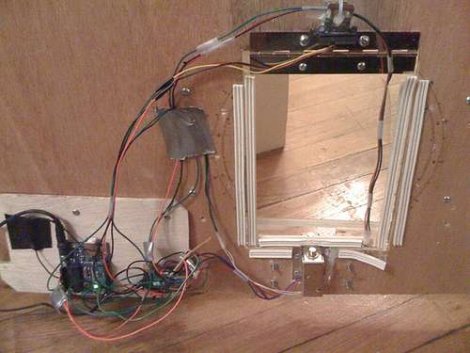
RFID cat flaps are one of those projects we see all of the time. They are generally pretty simple to rig up, not too expensive, and have a good “wow” factor for any non-technical friends or family, not to mention tremendously useful. Why did we decide to share this one? Well, for one, it is simple. It doesn’t tweet, email, or text message, it just gets the job done. Two, it is excellently documented, including a detailed parts list and a step by step schematic just about anyone could use to build their own. [landmanr] does mention that he recommends some sort of project enclosure to protect the electronics from damage, which would be bad for the poor cat stuck outside.














Blissified.
http://daid.mine.nu/instructabliss/?url=http://www.instructables.com/id/RFID-cat-door/
Yeah, an enclosure to protect it from the cat!
explain 1 part to me
how do you keep said cat from finding all of those fun tasty dangling wires and using them to either a: play with or b: clean his teeth
It says the cat has an rfid on it, but many cats have an implanted ID chip, which is also rfid, couldn’t you read that (if you had a properly equiped cat?)
@Hirudinea – That’s what I want too, but I can’t seem to find any good info on reading the #@$% implanted RFID tags. They use a special protocol or something and aren’t read by standard 125k RFID readers.
Anyone know how to read an implanted pet RFID tag with an arduino, etc?
The chips animals are implanted with (as I understand it) come in two different varieties. The older variety had a flaw where it is hard to read even if you know where it is. The newer one takes care of that but the range still is not great. The chips also have a tendency to drift away from there original position(back of the neck) A RFID tag in the collar would be my choice implementation. The reader would be easer to setup (on the door rather then in an animal tunnel)
I made mine to read the imbedded RFID tag, however I used a modified ag RFID reader, It may be because most standard hobby modules just read HDX tags rather than the full duplex tags commonly used to tag pets?
My folks recently bought a commercial version of this, that uses the implanted chips in their cats.
It seems to work pretty well, and has about a 4-6″ range.
The only difficult bit was persuading the cats to go through the receiver the first time to program them in. Why is it that cats can always tell when you want to do something undignified with them?
I has scratches.
My cat(RIP) would have had those wires shredded up in a jiff, but the pic is probably from the early stages.
It’s always cool to see these types of projects.
Quote: Why did we decide to share this one? Well, for one, it is simple.
Well, not as simple as the one I saw recently in a program about this eccentric british inventor Arthur Pedrick:
http://en.wikipedia.org/wiki/Arthur_Paul_Pedrick#Chromatically_selective_cat_flap
Essentially he uses a light sensor to keep the neighbour’s black cat out…
I live in chicago and its really cold. So my cat figured out that I tap the space heater to get the thermostat to kick on or off. My cat now walks in and bats the nob of the heater trying to get it to turn on. Seeing this makes me think my idea to build a cat switch for the heater might not be as crazy as i had thought.